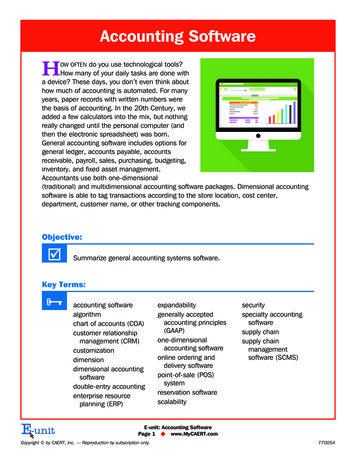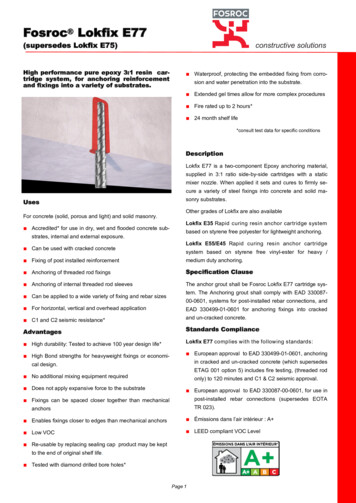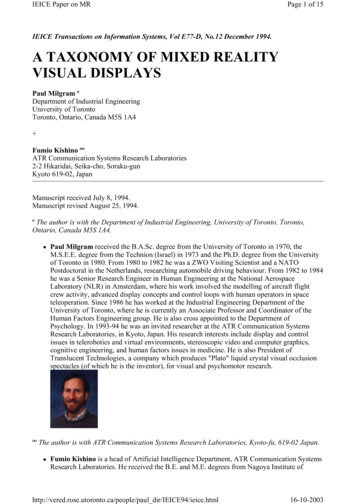
Transcription
Accounting SoftwareHOW OFTEN do you use technological tools?How many of your daily tasks are done witha device? These days, you don’t even think abouthow much of accounting is automated. For manyyears, paper records with written numbers werethe basis of accounting. In the 20th Century, weadded a few calculators into the mix, but nothingreally changed until the personal computer (andthen the electronic spreadsheet) was born.General accounting software includes options forgeneral ledger, accounts payable, accountsreceivable, payroll, sales, purchasing, budgeting,inventory, and fixed asset management.Accountants use both one-dimensional(traditional) and multidimensional accounting software packages. Dimensional accountingsoftware is able to tag transactions according to the store location, cost center,department, customer name, or other tracking components.Objective:þSummarize general accounting systems software.Key Terms:Ñaccounting softwarealgorithmchart of accounts (COA)customer relationshipmanagement (CRM)customizationdimensiondimensional accountingsoftwaredouble-entry accountingenterprise resourceplanning (ERP)expandabilitygenerally acceptedaccounting principles(GAAP)one-dimensionalaccounting softwareonline ordering anddelivery softwarepoint-of-sale (POS)systemreservation softwarescalabilitysecurityspecialty accountingsoftwaresupply chainsupply chainmanagementsoftware (SCMS)E-unit: Accounting SoftwarePage 1 u www.MyCAERT.comCopyright by CAERT, Inc. — Reproduction by subscription only.770054
Accounting Software: Types, Functions,and FeaturesAccounting software is an application used to record, processes, and maintain financialtransactions. It can usually manage accounts and perform multiple accounting operations. Theadvantages of a computerized system over a manual system include increased accuracy, processing speed, automatic calculations, lower costs, timely reports, and linking transactions totax reporting.ACCOUNTING SOFTWARE: GENERAL PRINCIPLESAccounting software should follow generally accepted accounting principles, specificallydouble-entry accounting. The generally accepted accounting principles (GAAP) are acommon set of standards and procedures used by companies to create financial statements. Acertified public accountant (CPA)uses GAAP for financial reporting. Double-entry accountingis the recording of each transaction in a minimum of twoaccounts. (There are at least onedebit and one credit per transaction.) Account entries have a leftside (debit side) and a right side(credit side). For each transaction,two accounts are impacted. [Forexample, a loan of 5000 wouldbe entered in a cash-on-hand ledger and an asset liability ledger (aFIGURE 1. Accounting software should follow generally accepted accountingdebit in one and a credit in theprinciples (GAAP), specifically double-entry accounting.other).]FeaturesAccounting software features range from reporting to security.Reporting and COAGeneral reporting and analysis functions help companies comply with compulsory government and industry reporting requirements. According to WhatIs.com, a chart of accounts(COA) is a “financial organizational tool that provides a complete listing of every account in anaccounting system.” The website also states, “An important purpose of a COA is to segregateexpenditures, revenue, assets and liabilities so that viewers can quickly get a sense of a company’s financial health. A well-designed COA not only meets the information needs of manE-unit: Accounting SoftwarePage 2 u www.MyCAERT.comCopyright by CAERT, Inc. — Reproduction by subscription only.770054
agement, it also helps a business to comply with financial reporting standards.” (Source:WhatIs.com.)GraphicsThe software should also provide graphics that present charts and graphs to illustrate company financial data.CustomizationCustomization is the ability of the software to be adjusted to fit company-specific needs.ScalabilityAs a business grows, scalability is the capacity of the software package to accommodatelarge numbers of users and an increasing amount of data.ExpandabilityExpandability is the capacity of the software package to allow additional modules to beadded as business needs change. For example, your business may not initially need a module tobill customers. As the business expands, you may need to add accounts receivable billing. Typical accounting software modules include general ledger, accounts payable, accounts receivable,payroll, sales, purchases, budgets, inventory, and fixed asset management.SecuritySecurity is your defense for a business’s financial data against loss, robbery, or tampering.Specialty Accounting SoftwareSpecialty accounting software is designed to meet industry-specific needs: hospitality(hotels, restaurants, or resorts),financial (banking, stocks, orinsurance), healthcare, manufacturing, retail, or governmentoperations. Many examples ofspecialty accounting softwaretechnology can be found today.POS SystemA point-of-sale (POS) system is a computerized cash register system that accepts credit anddebit payments from customers.FIGURE 2. Almost any industry that sells a product now uses a POS system. Apoint-of-sale (POS) system is a computerized cash register system thataccepts credit and debit payments from customers. Newer POS systems alsotrack inventory; text or email receipts; complete transactions on a mobilephone; and analyze customer and sales data.E-unit: Accounting SoftwarePage 3 u www.MyCAERT.comCopyright by CAERT, Inc. — Reproduction by subscription only.770054
Newer POS systems also track inventory; text or email receipts; complete transactions on amobile phone; and analyze customer and sales data. Many restaurants now provide pay-at-thetable kiosks for customers.Reservation SoftwareReservation software is a program used to schedule an appointment, control the flow ofcustomers, and manage a business’s available space. Some reservation systems allow customersto make bookings online, while others use in-house reservation software. This software goeshand-in-hand with accounting to help management determine:tThe maximum customer capacity of the facilitytThe correct number of employees to schedule for each working shiftOnline Ordering andDelivery SoftwareOnline ordering and delivery software is a system thatorganizes customer orders forpickup and delivery from a brickand-mortar store or a distributioncenter. Many restaurants now usemobile apps to accomplish thistask. Specialized software is alsoavailable for monitoring andreplenishing inventory online.This software also tracks expensesfor inventory purchases.Supply ChainA supply chain is a networkFIGURE 3. Online ordering and delivery software is a system that organizeof steps involved in moving acustomer orders for pickup and delivery from a brick-and-mortar store or aproduct or service from the supdistribution center. Many restaurants now use mobile apps to accomplishthis task.plier to the customer (from production to distribution). Supplychain management software (SCMS) is a shared program between businesses and suppliers that manages transactions, supplies, and related business processes. This software is usedto fill customer orders, purchase inventory, and monitor warehouse stock. A requirement ofmany SCMS packages is a forecasting tool. The function of forecasting is to balance supply anddemand disparities (differences or gaps). Forecasting tools use algorithms to predict futureneeds within the supply chain. An algorithm is a sequence of mathematical steps used to calculate or problem-solve a specific occurrence.E-unit: Accounting SoftwarePage 4 u www.MyCAERT.comCopyright by CAERT, Inc. — Reproduction by subscription only.770054
FURTHER EXPLORATION ONLINE CONNECTION:The Evolution of Accounting SoftwareTo learn more about the last 60 years ofaccounting software development, check outBen Scott’s six-part series,“The AccountingJournal: 60 Years of Accounting Software,” onthe MYOB website at g-softwareintroduction/.In his first article, Scott says, “Although the modern digitalcomputer developed gradually over decades, the first time amodern computer was sold to a private business and usedfor accounting purposes was in 1955—60 years ago now.”Personal UseAccounting software is also available for your personal use to track income and expenses,pay bills, and monitor debt and cash flow. Generally, simple, personal accounting softwarepackages do not offer the expandability options available to businesses. Personal accountingsoftware is often linked to online banking. This can allow direct access to bank accounts andthe use of online bill payment.ACCOUNTING SOFTWARE: DIMENSIONALOrganizations with multiple locations, clients, or product lines use a multidimensionalCOA to track their accounting transactions. Dimensional accounting software is anapplication that uses tagged transactional information as well as operational data with dimensional values.DimensionsIn dimensional accounting software, a dimension is an attribute that can be attached totransactions to capture information, such as departments, locations, customer names, cost centers, or other tracking needs.Dimensions allow you to categorize and analyze financial information to make better business decisions. As you create reports, drop-down lists may be used to filter, group, and organize data by dimensions. A standard income statement may be transformed into a report ofprofitability by a project or revenue by a geographic location. As a business changes, dimensions may be added to easily track data important to that business.E-unit: Accounting SoftwarePage 5 u www.MyCAERT.comCopyright by CAERT, Inc. — Reproduction by subscription only.770054
For example, a restaurant with many locations might want to track revenue and expensesbeyond the basic account level. As the accountant, you want to identify each transaction bylocation, so you can report and analyze financial information by locality. This information provides management with data about location profitability, margins, fixed assets, and more.CodingMultidimensional software operates with the use of multiple codes. According to the SageIntacct website, “Most financial solutions use a hard-coded structure for the COA. For example, to track three locations, five departments, and five projects, the accountant would need 75account code combinations—and you’d end up with a complicated, unmanageable set ofcodes.” (More can be read at cialreporting-system.)Let’s say that your firm has a client (Jones Group) that has asked you to throw an anniversary party. The party will be handled by your event department in the Cooperstown, NewYork location. The client’s account will be billed for the party.tAssuming the basic revenue code for client revenue is “400,” a location code extension of“250” would indicate the code for a specific client (Jones Group). The base code for theJones Group on all accounts is “400-250.”tThen, the department specification is needed, so another code could be added, such as“100,” for the Cooperstown event services department. This creates the code “400-250100.”tYou would also need to specify the project within that client account, so another extension would be added that creates the final code for this one event as “400-250-100-50”(with “50” indicating the Jones Group anniversary party).In short, when you must enter individual transactions, the coding process can become verycumbersome and may require that hundreds of extra accounts be created. Multidimensionalsoftware can aid in the creation and maintenance of account codes.Types and ProvidersThere are many types of dimensional software and many companies that provide dimensional software packages.One-DimensionalOne-dimensional accounting software is a traditional package that does not offermultiple dimensions. This package may be the best choice for individuals and businesses thatrequire only basic financial reports or budgets. QuickBooks, by Intuit, is a popular one-dimensional accounting system.E-unit: Accounting SoftwarePage 6 u www.MyCAERT.comCopyright by CAERT, Inc. — Reproduction by subscription only.770054
CRMCustomer relationship management (CRM) is multidimensionalsoftware that helps businesses managecustomer data, sales, and support. It is acategory of software that covers a broadset of applications designed to manage abusiness-customer relationship. CRMsoftware systems are also used to manage contacts, employees, and the company’s web presence. Companies likeSalesforce offer a mainly cloud-basedCRM, while others, like Microsoft,offer on-premises or cloud versions.ERPEnterprise resource planning(ERP) is multidimensional softwarethat manages and integrates the important parts of a business (often a manufacturing business): product planning,development, manufacturing, sales, andmarketing. It integrates many functionsrelated to technology, services, andhuman resources. It is scalable, and itsfunctionality includes security,workflow, reporting, and a multi-module system. Some companies, like Oracle NetSuite, only offer cloud-basedERP software, while other companies,such as Infor, offer both options (or ahybrid of the two).FIGURE 4. CRM software systems are used to manage contacts,employees, and the company’s web presence. Companies likeSalesforce offer a mainly web-based cloud CRM, while others, likeMicrosoft, offer on-premises or cloud versions.PackagesThe larger the company and its operations, the more likely is its need fordimensional accounting software assistance. Several dimensional accountingsoftware packages are available at a variety of price points. Individuals andsmaller businesses may not require thepower and flexibility of multidimen-FIGURE 5. An ERP program integrates many functions related totechnology, services, and human resources.E-unit: Accounting SoftwarePage 7 u www.MyCAERT.comCopyright by CAERT, Inc. — Reproduction by subscription only.770054
sional accounting software—the cost may outweigh the benefits. Some popular dimensionalaccounting software packages include:tSage IntaccttQuickbooks EnterprisetOracle NetSuitetZohotMicrosoft Dynamics 365Summary:2Accounting software is used to record, processes, and maintain financial transactions. Typical accounting software modules include general ledger, accounts payable, accounts receivable, payroll, sales, purchases, budgets, inventory, and fixedasset management. Accounting software also provides reporting and analysis functions.Specialty accounting software is designed to meet industry-specific needs: hospitality (hotels, restaurants, or resorts), financial (banking, stocks, or insurance),healthcare, manufacturing, retail, or government operations. Many examples of specialty accounting software technology can be found today.A supply chain is a network of steps involved in moving a product or service fromthe supplier to the customer (from production to distribution). Supply chain management software (SCMS) is a shared program between businesses and suppliersthat manages transactions, supplies, and related business processes. This software isused to fill customer orders, purchase inventory, and monitor warehouse stock.Dimensional accounting software is able to tag transactions according to store location, cost center, department, customer name, or other tracking components. Inaccounting software, a dimension is an attribute that can be attached to transactionsto capture information, such as departments, locations, customer information, costcenters, or other tracking needs. Dimensions allow accountants to categorize andanalyze financial information to make better business decisions. The two maindimensional accounting software formats for businesses are customer relationshipmanagement (CRM) and enterprise resource planning (ERP).Checking Your Knowledge: 1. List and briefly describe the main features of accounting software.2. Differentiate between the scalability and the expandability of accounting software packages.3. What makes security an important feature of accounting software?E-unit: Accounting SoftwarePage 8 u www.MyCAERT.comCopyright by CAERT, Inc. — Reproduction by subscription only.770054
4. Describe dimensional accounting software.5. Describe CRM and ERP accounting software. Which industries use eachtype?Expanding Your Knowledge:LThere are many dimensional accounting software options available in today’s market. Review three different dimensional accounting software package tutorials bygoing to https://www.youtube.com/results?search query dimensional accounting software on YouTube. Which industries are likely to useeach type?Web Links::Best Personal Finance Services 0.aspIndeed Programmer ing-Software-jobs.htmlSoftware Developers (Bureau of Labor formation-Technology/Softwaredevelopers.htmE-unit: Accounting SoftwarePage 9 u www.MyCAERT.comCopyright by CAERT, Inc. — Reproduction by subscription only.770054
(hotels, restaurants, or resorts), financial (banking, stocks, or insurance), healthcare, manufac-turing, retail, or government operations. Many examples of specialty accounting software technology can be found today. POS System A point-of-sale (POS) sys-tem is a computerized cash regis-ter system that accepts credit and debit payments from .

